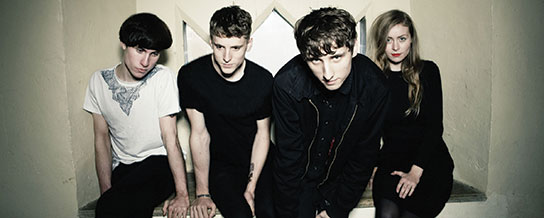Don’t Stop the Rock: Part 5
Now that the wall between rock purism and the digital dancefloor has been reduced to […]

Don’t Stop the Rock: Part 5
Now that the wall between rock purism and the digital dancefloor has been reduced to […]

Now that the wall between rock purism and the digital dancefloor has been reduced to mere rubble, a suite of newer, harder, brighter, faster bands are getting down to the business at hand: having a good time. In our final installment of this series, Britain’s newest illusionists, These New Puritans, conjure up Wu-Tang-inspired attack rock.
British band These New Puritans are enigmatic. Or at least they attempt to be. “We approached the band like casting a spell,” states frontman Jack Barnett. “We’re more magicians than musicians.”
Eccentricity has been a hallmark of the four-piece since they formed in 2005–and having a demonstrative pronoun in their name is just the start. The band’s hyped debut, Beat Pyramid,overflows with cryptic phrases and song fragments that are constantly repeated and referenced. When Barnett repeats the line “Every number has a meaning” on the jittery “Numerology,” he hammers home a lyrical conceit and a numeric obsession. On “Sword of Truth,” he mutters something about “riding the airwaves,” and occasionally seems to be in the middle of his own esoteric radio broadcast, uttering phrases that fall somewhere in between nonsense and coded message.
Barnett is a devoted Wu-Tang fan, and while his hometown of Southend-on-Sea is far from Staten Island, he shares the rap group’s obsession with conspiracies, double meanings, and hidden objects. At one point the band members even toyed with the idea of naming their debut album Liquid Swords, a GZA tribute that would have befitted their agressive sound: an amalgam of post-punk riffs, warning-siren synths, and jarring, shouted lyrics that Barnett describes as “attack music.”
Produced by Gareth Jones, who has worked with Wire and Liars, Beat Pyramid fashions the sounds of scraping knives and field recordings from shooting ranges into bludgeoning rhythm tracks. Post-industrial angst courses throughout in the form of snarling guitars, mechanical rhythms, and a piston-like bass lick on “En Papier.” Other tracks like “Colours” build to ecstatic crescendos, fitting into the song template established by groups like Bloc Party and Klaxons.
Initially, the album was supposed to be even weirder. Originally conceived as a tribute to London, it was going to contain field recordings from different parts of the city–when the locations were plotted on a map, the resulting shape would be an infinity sign (a reference that appears frequently in the group’s music videos). This sort of high-concept mysticism can come off as cute affectation or something more “meta,” but unlike Wu-Tang, Barnett doesn’t believe in conspiracy theories or numerology, merely viewing them as “useful ideas.”
So is there a reward for fans who sift through the album’s clues and half-truths? “They’ll achieve a spiritual calm,” says a droll Barnett. “Or not.”
Don’t Stop The Rock Part 1: Cut Copy
Don’t Stop The Rock Part 2: Does It Offend You, Yeah?
Don’t Stop The Rock Part 3: Late of the Pier
Don’t Stop The Rock Part 4: The Teenagers

